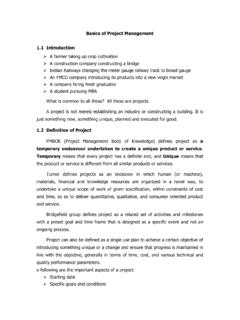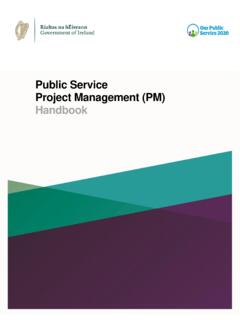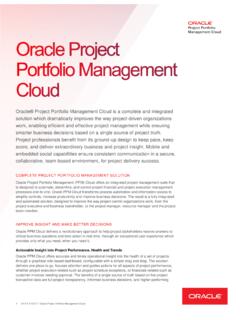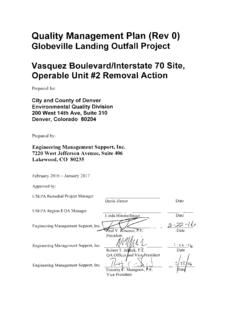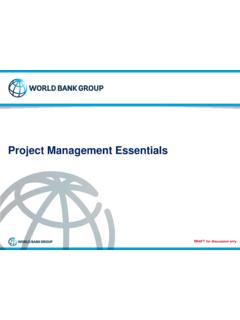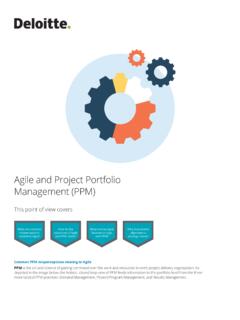Transcription of Project Management in Research and Development
1 Project Management in Research and Development WHITE PAPER 2010, Revision 0 Prepared by: Energy Facility Contractors Group (EFCOG) Project Management Working Group Project Management in R&D December 2010, Revision 0, Original Issue Page 2 CONTENTS 1. BACKGROUND .. 4 Requirements and Standards .. 4 Noteworthy Precedence .. 5 Research and Development Project Characteristics .. 5 Development (also termed Research and Development ) Activities .. 5 Deployment Activities .. 6 2. OBJECTIVE .. 6 3. DISCUSSION .. 7 Technology/ Research Readiness .. 7 Progressive Scope/Baseline Definition .. 8 Configuration Management /Trending .. 11 Configuration Management .. 11 Trending .. 11 Key Points .. 12 Application of Earned Value Management Techniques to Research and Development Projects .. 13 Project Controls in Research and Development .
2 15 4. VALUE PROPOSITION .. 17 To Customer .. 17 To Program Managers, Project Managers, Direct Managers, and Principal Investigators .. 17 To Enterprise Level Project /Program Management .. 18 5. CONCLUSION .. 18 6. REFERENCES AND ADDITIONAL READING .. 19 7. CONTRIBUTORS .. 19 Appendix A, Risk Screening and Identification Checklist .. 20 Project Management in R&D December 2010, Revision 0, Original Issue Page 3 FIGURES 1. Progressive definition narrows, but delays freezing of requirements .. 10 2. Deployment versus Development Project life cycle comparison .. 10 3. Paper Development schedule .. Error! Bookmark not defined. TABLES 1. Sample of tailored approach to Project controls .. 15 Project Management in R&D December 2010, Revision 0, Original Issue Page 4 1. BACKGROUND This white paper was developed by the Energy Facility Contractors Group Project Management Working Group as a collaborative effort among Department of Energy (DOE) contractors, subcontractors, and the Project Management Institute government international representative.
3 The white paper was developed to explore approaches, benefits, and limitations in the application of Project Management principles and practices to DOE Research and Development (R&D) projects and programs (Figure 3). A generally accepted tenet is that the application of appropriately applied Project Management principles and practices enhance technical, cost, and schedule performance and provide predictability in the execution of all projects. The proposition of this white paper is that providing a Project Management approach to DOE R&D work will benefit DOE, the DOE contractor, the R&D community, and the public. The focus on cost-effectiveness of program expenditures is increasingly being called into question. There has been congressional interest over recent years in improving DOE Project Management focused on capital construction projects.
4 A DOE Corrective Action Plan currently is being implemented and championed by the DOE Office of Engineering and Construction Management . Although DOE capital construction projects grab the spotlight, most projects under DOE Management are in the R&D environment. With shrinking federal budgets and considering the substantial DOE R&D scope, at this time, it is prudent to explore best practice Project Management models in the R&D environment for broad application, including consideration of a standards-based approach. Requirements and Standards DOE Order , Program and Project Management for the Acquisition of Capital Assets, provides DOE Project Management requirements and guidance for using a graded approach; however, the order and application to R&D type projects is not specifically mentioned. The requirements set forth by DOE Order support following universally accepted Project Management principles applicable to the full range of DOE projects, including the following: Line Management accountability Sound, disciplined, up-front planning Development and implementation of sound acquisition strategies Well-defined and managed performance baselines Effective Project Management systems ( , quality assurance, risk Management , change control, and performance Management ) Implementation of an Integrated Safety Management System Effective communication among all Project stakeholders.
5 There is general agreement that application of Project Management skills, tools, and techniques will increase the probability of success over a wide range of projects. The Project Management Institute (PMI), for example, publishes A Guide to the Project Management Body of Knowledge (PMBOK Guide), which is recognized as a best practices standard for Project Management . While not specific to the type or nature of the Project , it is up to the user to apply these best practices in a manner that befits the Project . Project Management in R&D December 2010, Revision 0, Original Issue Page 5 Noteworthy Precedence Other government agencies and private industry have successfully applied Project Management processes to benefit R&D objectives for a number of years. The National Aeronautics and Space Administration (NASA) is a forerunner in successfully applying Project Management to R&D.
6 NASA has used a Project Management organizational model on R&D projects to provide benefits through a sound Project Management approach. Individual contracts within the DOE community, either through contract clause or best practice, have developed Project Management techniques for managing R&D projects. DOE has experienced successes in the application of Project Management methodology to R&D projects conducted at some of the National Laboratories. This paper provides some examples of graded Project Management enterprise approaches to R&D type work . Research and Development Project Characteristics R&D activities can be characterized as complex, interdependent, responsive to sudden Research environment changes ( , breakthroughs, new barriers, and collaboration changes), and heavily reliant on expert judgment to maintain quality, relevance, and performance.
7 The technical excellence of R&D activities is largely assessed through peer review of projects and the use of review of programs by advisory committees (or other outside expert panels). The output from merit evaluations, workshops, expert panels, and other pieces of information are combined by knowledgeable and experienced technical program managers to ensure that R&D programs remain relevant. While the process is largely qualitative in nature, results are often quantitative. The quality of R&D projects can be measured by assessing the degree to which the Project has met or exceeded customer requirements. Federal R&D Project customers may prioritize which of the triple constraints are most critical to their efforts ( , scope specifications and capabilities; cost in various units of resources; or schedule both interim milestones and completion of final deliverables).
8 When federal funding is fixed annually at the beginning of each fiscal year and customers require deliverables by a certain date, R&D projects frequently are required to offer maximum scope flexibility for a negotiated cost and schedule. The process by which R&D activity performance is monitored and documented, by necessity, varies greatly across projects and programs. Large-scale, complex construction projects follow clear and validated processes with quarterly milestones and regular review cycles. This method is neither appropriate nor meaningful for an R&D program typically one of a kind that measures progress toward answering a list of key questions through a variety of approaches for periods that may not have a hard-fixed end date. DOE and NNSA offices are increasingly demanding a more structured ( Project ) approach to R&D work, recognizing that one size does not fit all.
9 Development ( Research ) and deployment (traditional construction) projects are characteristically different in objectives, structure, and methods; they require a different level of rigor in the Project Management process as discussed in this white paper. Development (also termed Research and Development ) Activities Development activities are conducted to acquire and disseminate new knowledge of a theoretical or experimental nature. Several sets of attributes may apply to these projects, including the following: Project end goals (a well-defined set of milestones and deliverables) may be well known but the method and path for achieving them ( , Research , engineering, and fabrication) are not Project execution methods may be well known but the end goals are not Neither methods nor goals may be well known. Project Management in R&D December 2010, Revision 0, Original Issue Page 6 Deployment Activities Deployment activities are conducted on fixed scope projects using established knowledge.
10 Attributes that apply to this type of Project include the following: Goals ( , scope, cost, and schedule baseline) are well known Methods (execution process) for achieving those goals are well known Methods for quantitatively measuring progress against the goals ( , unit rates, volumes of materials, and length of installed materials) are well known. Unlike construction-type projects, R&D projects are not defined, repeatable processes. Attempting to create detailed, task-oriented plans for R&D projects early in their life cycle is likely to lead to frustration and time spent updating plans rather than managing the project1. Traditional Project Management , as defined for example in the PMI PMBOK Guide, is focused on planning . The underlying assumption is that planning enough, tracking against the plan, and taking corrective action when work deviates from the plan will result in a successful Project .
